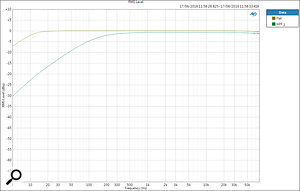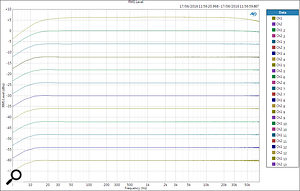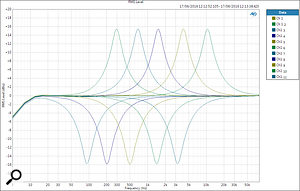These new TAC modules bring the classic Amek console sound to your Lunchbox rack.
Total Audio Control are relatively new manufacturers based in Glasgow, Scotland. The enterprise is the brainchild of Cemal Ozturk, but it’s his collaborator Graham Langley who is better known — in fact, he is one of the pro-audio industry’s best-known British audio designers. (For more on their backgrounds, see the ‘Ozturk & Langley’ box.) The company began by offering DIY kits, but they’ve recently launched their first two fully assembled products — the MicPre One and the EQ One. I received one of each for this review. Both feature black faceplates (a silver metallic finish is also available) with clear white legends, elegant black knurled knobs, and illuminated buttons, and both were designed by Graham Langley. For testing, I installed the modules in a standard API Lunchbox.
MicPre One
The MicPre One is the first in TAC’s ‘Designed by Langley’ product line, and its circuitry is apparently developed from the transformerless preamp originally employed in the Amek M2500 and Angela analogue mixing consoles in the early 1980s. The initial gain stage is based around paralleled, matched, discrete transistors, with constant current sources, and the design is claimed to deliver a very good noise performance, especially at low gain settings — and that’s where many mic preamps struggle. The published EIN specification is quoted as -128dBu (with a 150Ω source and 22Hz-22kHz measurement bandwidth), which is within a couple of decibels of the theoretical maximum (-130.5dBu).
 The MicPre One features switchable input impedance, amongst all the usual preamp features.
The MicPre One features switchable input impedance, amongst all the usual preamp features.
Unusually, the preamp’s signal path is balanced all the way through the unit, and the gain is adjusted with a rotary switch in 6dB steps over a 66dB range. A continuous rotary trim control placed above the gain switch provides a further 4dB of gain (allowing a maximum of 70dB), or up to 20dB of attenuation, and is intended to allow precise gain matching with other preamps, or to trim the output level to suit other equipment.
 The MicPre One is constructed on two PCBs.
The MicPre One is constructed on two PCBs.
Below the gain knob is a block of six illuminated buttons, the first four performing the familiar functions of activating phantom power, flipping the output polarity, introducing a passive high-pass filter (6dB/octave from 120Hz, and placed before the gain stage), and changing the input impedance. This last switch toggles the mic input impedance between 5kΩ and 600Ω. MicPre One high-pass filter.
MicPre One high-pass filter.
A front-panel quarter-inch TRS socket accepts either balanced or unbalanced instrument or line sources, and it is selected in place of the rack chassis’ mic input by pressing the fifth illuminated button. The default input impedance is 1.5MΩ, which is ideal for electric instruments, but this can be changed by the Lo-Z button, courtesy of a user-selectable internal jumper link. The options are to remain at 1.5MΩ (so that pressing the button has no effect), or to reduce to 50 or 10 kΩ. These lower impedance options are much better suited to unbalanced and balanced line inputs, respectively.
Unusually, there’s a second quarter-inch socket on the front panel and this provides a balanced output. This normally serves as a direct ‘thru’ feed of the instrument input to connect with an amplifier. However, the sixth illuminated button reconfigures it to provide a duplicate line-level preamp output instead. (The company’s MicPre Three module is a lower-cost model using exactly the same preamp circuitry as the MicPre One, but omitting the instrument input and thru/monitor output.)
An eight-LED bar-graph meter with quasi-PPM ballistics displays the output level before the output trim control (although it can be reconfigured internally to post-trim-control if required). The bottom five green LEDs start at -18dBu (marked ‘SP’ for ‘Signal Present’), with -12, -8, -4 and 0dB indications. The +4 and +8 dB LEDs are yellow, while the top red LED is marked as +18dB. This last indicator has a faster attack and slower decay time than the rest to make transient peaks very obvious. In fact, this ‘peak’ LED comes on at a generous 9dB below clipping, as the maximum output level from the MicPre One is a whopping +27dBu. MicPre One gain steps.
MicPre One gain steps.
The published frequency response is given as 20Hz-80kHz (±0.5dB), with the phase response staying within ±30 degrees across that range, and the THD is below 0.5 percent (for a +10dBu input signal). It’s all impressive stuff, and exactly what we’ve come to expect from the Langley drawing board. The unit employs through-hole components. The circuitry includes no fewer than five OP275s op-amps, along with a couple of NE5532s, and a THAT 320 chip, which provides the four matched PNP transistors in the paralleled input stage. Current consumption from the host rack is a very modest 78 and 63 mA on the positive and negative power rails, respectively.
EQ One
Like the MicPre One, the EQ One is based on a classic Amek design by Graham Langley, and in this case it’s the four-band parametric EQ with filters that was first introduced on the M3000 console, and remained in use across most subsequent Amek desks. But, once again, the new TAC incarnation is not quite identical to the circuit that inspired it — not only have the frequency bands been modified slightly to better suit stand-alone applications, but the noise performance has also been improved.
 The EQ One features four bands of bell EQ, two of which double up as shelves, as well as both high and low pass filters.
The EQ One features four bands of bell EQ, two of which double up as shelves, as well as both high and low pass filters.
 EQ One filters.A pair of adjustable high- and low-pass filters can be placed at the start of the signal path, with 12dB/octave slopes spanning 20-400 Hz for the high-pass and 20-0.7 kHz for the low-pass. The four-band parametric section can also be switched in and out of circuit, and is an unusual design in that each band actually comprises linked but separate first-order (6dB/octave) high and low-pass filters with different turnover frequencies. This arrangement allows the bandwidth to be adjusted over a very wide range, and also caters for selectable bell or shelf responses in the top and bottom bands (the bandwidth/Q control is disabled in shelf mode).
EQ One filters.A pair of adjustable high- and low-pass filters can be placed at the start of the signal path, with 12dB/octave slopes spanning 20-400 Hz for the high-pass and 20-0.7 kHz for the low-pass. The four-band parametric section can also be switched in and out of circuit, and is an unusual design in that each band actually comprises linked but separate first-order (6dB/octave) high and low-pass filters with different turnover frequencies. This arrangement allows the bandwidth to be adjusted over a very wide range, and also caters for selectable bell or shelf responses in the top and bottom bands (the bandwidth/Q control is disabled in shelf mode).
The front-panel controls start at the top with a pair of knobs for the high- and low-pass filter turnover frequencies, together with an illuminated button to switch the pair into circuit. Below these are four rows of three knobs — one row for each EQ band — comprising centre frequency, boost/cut, and bandwidth controls. In the top and bottom left-hand corners are buttons to switch the top and bottom bands into bell mode instead of the default shelf response. The final control is a button in the bottom right-hand corner, which switches this entire parametric EQ section into circuit. A tri-colour LED at the bottom of the panel glows green for signals levels above -18dBu, turning yellow above +4dBu and red at +18dBu (9dB below clipping). EQ One low-frequency shelf.
EQ One low-frequency shelf.
Each of the four bands overlaps the frequency range of its neighbours nicely, with the low band spanning 32-1000 Hz, the low mid 0.1-3.2 kHz, the high mid 0.32-10 kHz and the high band 0.66-20 kHz. All have a ±15dB boost/cut range. The top and bottom bands can be adjusted for bandwidths between Q values of 0.25-1.5 (5.7-0.9 octaves), while the two middle bands span Qs of 0.5-3.2 (2.8-0.37 octaves). In other words, they range from very broad to pretty narrow for the high and low bands, and reasonably broad to surgically narrow for the middle bands.
Construction is with conventional through-hole components once again. The active devices include nine NJM5532s, which handle most of the EQ amplification duties, and three OP275 op-amps which cater for the balanced I/O. The technical specs quote an operating bandwidth of 20Hz-80kHz ±0.5dB, with maximum I/O levels of +27dBu, THD better than 0.05 percent, and noise (with filters and EQ switched in) of better than -90dBu — all highly respectable figures. EQ One high-frequency shelf.
EQ One high-frequency shelf.
Module power consumption can be an issue with some 500-series manufacturers, because the original API specifications only allowed a maximum of 160mA per power rail, per module. As the EQ One occupies two module slots, though, its allowance is doubled to 320mA per rail — though in fact it only draws a quiescent current of 130 and 111 mA from the positive and negative rails, respectively. Even with a peak +24dBu input signal the current demand rises only to 163/144 mA, so it is very comfortably within the specifications.
In Use
Given the design pedigree it came as absolutely no surprise to me that both the MicPre One and the EQ One are excellent 500-series modules: they’re well designed and specified, well built, very easy to use, and sound great. EQ One LF and HF bands, maximum bandwidth.
EQ One LF and HF bands, maximum bandwidth.
I started my testing and auditioning with the EQ One, and I found it very easy to use in a physical sense — although the knob spacing is actually fairly dense, I could still get my fingers onto the controls without difficulty. It was also immediately apparent that the reputation Amek held for their very ‘musical-sounding’ equaliser designs is fully intact here. The inclusion of separate filters is a very useful feature, allowing a source to be carefully ‘bracketed’ to remove unwanted out-of-band elements while leaving the parametric section for the heavy lifting duties of creative tonal shaping or for performing quite precise surgical corrective work — particularly using the two mid bands. EQ One HMF and LMF bands.
EQ One HMF and LMF bands.
It occurred to me that a stereo version of the EQ One (EQ Two anyone?) could be a really nice tool for mix-bus and home-mastering applications, but as things stand, this mono unit makes the perfect partner for the MicPre One, to construct an effective and versatile 500-series channel strip. EQ One HMF and LMF bands, maximum bandwidth.
EQ One HMF and LMF bands, maximum bandwidth.
Moving on to the MicPre One, this really is a remarkably good preamp and a particularly versatile one for anyone recording a lot of instruments. I really like the configurable input impedance options for the instrument/line input, as well as the versatility of the direct amp loop-thru/second balanced output.
 EQ One bandwidth range, upper-mid.As a transformerless design, the preamp is very clean, neutral and quiet, doing what a good preamp should do — making the signal louder without imposing any strong characteristics of its own. If a character comparison is necessary, I’d suggest it shares much in common, tonally and dynamically, with Audient’s preamps. The relatively high 5kΩ mic-input impedance is welcome too — I always think this a better-sounding option than the traditional 1.5-2.5 kΩ offerings of most traditional designs.
EQ One bandwidth range, upper-mid.As a transformerless design, the preamp is very clean, neutral and quiet, doing what a good preamp should do — making the signal louder without imposing any strong characteristics of its own. If a character comparison is necessary, I’d suggest it shares much in common, tonally and dynamically, with Audient’s preamps. The relatively high 5kΩ mic-input impedance is welcome too — I always think this a better-sounding option than the traditional 1.5-2.5 kΩ offerings of most traditional designs.
Verdict
I could quibble about the colour choices for some of the button illuminations — I prefer mission-critical functions like phantom power to illuminate red, rather than yellow, while non-critical functions like polarity and impedance are better as yellow rather than red. But this is the tiniest of points to make about what are otherwise genuinely excellent products, made available at a genuinely attractive price. It’s good to see and hear Langley-designed products on the market again — I hope they’ll be followed by more before too long!
Ozturk & Langley
Born in Istanbul, Cemal Ozturk moved to London in 1986, and then to Glasgow in 1988, where he worked initially in model-making and prototyping. In 1996 he re-branded his company as Ozturk & Robotica to focus more on the electronics and robotics fields. After a chance meeting with Graham Langley, the pair decided to collaborate on a range of new pro-audio products under the Total Audio Control brand.
Graham Langley’s pro-audio career started in 1972, at Audio Developments near Birmingham, where he built mixing consoles and tape recorders. The following year he joined a Collective on a hill farm in Wales and built “four-channel mono mixers in purple boxes” as well as electronic crossovers, phasers, power amplifiers, and speaker cabinets, the last again being covered in purple paint-impregnated hessian. His customers included Alexis Korner and Fairport Convention.
Sadly, a car accident that killed several members of the Collective forced Langley to move back to Manchester. Here, a school reunion brought Nick Franks and Graham Langley together. They’d first met as 14-year olds at a Grammar School in Manchester. In the intervening years, Franks had studied at the London School of Economics, and so brought business skills to support Langley’s analogue design expertise. Langley had conceived the Amek name while on holiday in Cornwall in the mid-1960s, and the pair set up Amek’s first factory premises in Altrincham, on the southern edge of Manchester, in 1974.
One of Amek’s first major clients was a French psychedelic band called Gong, who commissioned the company to build a large, bespoke three-section winged console for a tour, along with amps, monitor console, and a lighting controller! Business progressed rapidly after that, and Amek consoles gathered a reputation for sounding very ‘musical’.
The second half of the 1970s saw the company launch the M-series modular split recording consoles, and S-series sound-reinforcement desks, and two years later the Total Audio Concepts (TAC) brand was introduced, with a low-cost 16:2 console. At the end of that decade Amek introduced the flagship M3000, a 24-bus recording console, and the M1000 top-of-the-range sound-reinforcement desk. The ’80s were just as busy, producing the M2500 and Angela consoles, the BC01 broadcast console, the TAC Matchless and Scorpion desks, and the assignable APC console with GML automation. During this time, the Amek factory moved to New Islington Mill in Salford, to the West of Manchester, TAC established a new factory in Devon, and Amek won the Queen’s Award for Exports three years in a row (1985-87). At the end of the ’80s the M2500 was replaced by the G2520, and the Mozart music recording desk and TAC Bullet multipurpose mixer were launched. But the really big news was that Rupert Neve joined the company as a consultant, with the Medici Equaliser being the first directly attributable product.
In the early 1990s Amek produced the BCIII broadcast console, Hendrix and Einstein music consoles, the TAC SR6000, the B2, and a new ‘...by Langley’ line, which included the Big-by-Langley music recording console and the Recall-by-Langley live sound desk — the latter was the first automated sound-reinforcement console with recall. Other highlights included the 9098 music console, the Rembrandt desk, and Amek’s first digital console, the DMS, in 1996.
Meanwhile, AKG acquired a shareholding in Amek back in 1992, but were themselves bought out by Harman in 1994. Inevitably, Harman went on to acquire Amek in 1997 and Nick Franks left the company to pursue new interests. Graham Langley stayed on for a further four years as Technical Director, delivering the Galileo, BB100, and Media 51 recording consoles, but he left in 2001 to set up Langley Design. Harman closed Amek down in 2004, although the BB100 console re-emerged under the Soundcraft brand in 2006 for a few years. Graham Langley had designed over 30 Amek consoles, many of which are still in use and highly revered and respected today.
Pros
- Microphone preamplifier topology fully balanced throughout.
- Configurable front-panel output on mic preamp.
- Adjustable and configurable mic preamp input impedance options.
- Excellent mic preamp performance.
- Versatile and musical-sounding EQ.
- Separate filters and four-band parametric.
Cons
- None.
Summary
This new range of 500-series modules, designed by Graham Langley, boasts superb technical performance, offers some unusual but beneficial facilities, and sounds great.
information
Total Audio Control + 44 (0)7789 792 831


